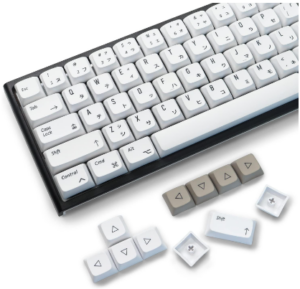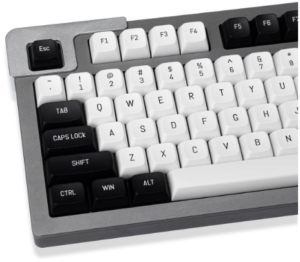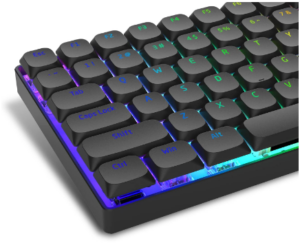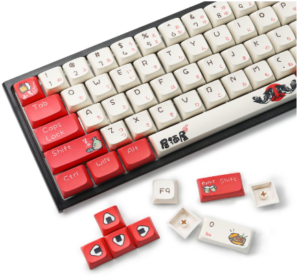Low Profile Keycaps: Top 8 Picks 2024

Our Top Picks For Low Profile Keycaps
The realm of mechanical keyboards is vast and ever-changing. For enthusiasts like us, the allure is undeniable. From the satisfying click of switches to the endless customization possibilities. It’s easy to lose track of time while exploring this fascinating world. Just as you think you’ve mastered the nuances, a new trend or innovation emerges, ensuring the learning never stops. One such trend that’s been generating buzz? Low profile keycaps. Their sleek design and unique feel have many intrigued, and today, we’re diving deep into what makes them so special.
Introduction To Low Profile Keycaps
Within the intricate landscape of mechanical keyboards, the evolution of components. Driven by a blend of ergonomics, engineering precision, and user interface dynamics. Mechanical keyboards, distinguished from their membrane counterparts, boast of intricate switch mechanisms, actuation points, and key travel distances. Each element, from the PCB (Printed Circuit Board) design, stabilizers, to the choice of keycaps, has a quantifiable impact on the overall typing or input experience.
Enter low profile keycaps, a recent innovation in the keycap domain. Unlike their traditional high-profile counterparts which have a pronounced height and curvature. Low profile keycaps are characterized by their reduced stature and a flatter surface profile. This isn’t merely an aesthetic adaptation; from a technical standpoint, these keycaps reduce the actuation distance, potentially offering faster key-press response times. This can be particularly advantageous for high-speed typists and competitive gamers seeking an edge in actuation speed.
Profiles
Shorter keycap profiles are becoming increasingly popular, especially among users who prefer a sleeker, more streamlined look and feel to their keyboards. These profiles often offer a flatter typing experience compared to their taller counterparts. Here’s a brief overview of some of the shortest keycap profiles.
- DCS: This profile is relatively low and sculpted, resembling the Cherry profile but being slightly shorter. Originating from Signature Plastics, DCS keycaps are often favored for their minimalistic design and comfortable typing experience.
- HHKB (Happy Hacking Keyboard): This isn’t a keycap profile per se, but a specific keyboard layout and design. However, the keycaps used on HHKBs are often lower profile, catering to the keyboard’s compact and efficient design ethos.
- R3: R3 refers to a specific row in some sculpted keycap sets. When an entire keyboard uses R3 keycaps, it gives the keyboard a uniform and flat appearance. These keycaps are often seen in SA or MT3 sets, but using only the R3 row provides that low-profile aesthetic.
- DSA: A popular choice for its uniformity, DSA keycaps are spherical and flat, offering a consistent feel across all rows. Their low height and even design make them ideal for those who enjoy a smooth, uninterrupted typing surface.
- XDA: Similar to DSA in its uniformity, XDA keycaps have a broader and flatter surface area. This offers a unique touch experience, allowing fingers to rest comfortably on the keys. Their simplicity in design has attracted many in the mechanical keyboard community.
- KAM: Emerging from the same vein as KAT profile keycaps, KAM is its uniform variant. They are spherical and flat like DSA and XDA but have a slightly different feel due to their unique design characteristics.
Actuation Point
At its core, the actuation point is the precise moment or position when a key switch registers a key-press. Imagine pressing a key; there’s a specific point during this downward motion where the computer recognizes the press, even if you haven’t pushed the key all the way down. This moment is the actuation point, typically measured in millimeters.
Variability: Different mechanical switches boast various actuation points. For instance:
- Linear Switches: Known for their smooth keystrokes, they have a consistent actuation point without tactile bumps.
- Tactile Switches: These switches feature a noticeable bump at their actuation point, providing physical feedback when a keypress is registered.
- Clicky Switches: Combining tactile feedback with an audible click, their actuation point is often right where the click sound occurs.
- Impact of Keycap Type: While the actuation point is primarily a feature of the switch, the keycap can subtly influence its perception. Heavier, thicker keycaps might make the actuation feel deeper, even if it technically remains the same. Conversely, lighter keycaps might create a sensation of a higher actuation point. This isn’t a change in the actual point of actuation but rather a shift in the tactile experience.
Importance for Typists and Gamers
The actuation point can greatly influence typing speed and accuracy. A higher actuation point might lead to faster typing since the keypress is registered sooner. For gamers, this can be crucial, as the milliseconds saved can mean the difference between victory and defeat.
Why Choose Low Profile?
In the intricate ecosystem of mechanical keyboards, it’s often a challenge to discern which components truly elevate the user experience. Enter low profile keycaps. To draw an analogy, imagine being behind the wheel of a state-of-the-art sports car. The design is low to the ground, enabling sharp, precise turns, and unparalleled responsiveness. Every minute detail of the car is engineered for performance, and this precision and focus on user experience mirror the intent behind low profile keycaps.
Low profile keycaps are not just a design choice; they’re a calculated evolution in keyboard technology. Their primary allure lies in the swift actuation they offer. In a keyboard switch setup, the actuation is essentially the moment the key-press is registered. With the reduced height of low profile keycaps, the distance to achieve this actuation is shortened. This minute but critical difference translates to an enhanced and more immediate response, optimizing typing and gaming sessions. For gamers, in particular, where split-second reactions can make or break gameplay, this rapid response can be a game-changer.
Our Top Keycap Picks
8. JSJT Keycaps with Japanese Legends

Features:
- Price: $39.99
- Colors: Navy, Cyan & White
- Profile: XDA
- Material: Dense PBT
- Key Compatibility: Various Cherry MX mechanical keyboards and additional keys included
7. SDYZ All White Keycaps With Japanese Legends

Features:
- Price: $22.69
- Color: White
- Profile: XDA
- Material: Five-sided sublimation PBT
- Key Compatibility: Adaptable from 60% to 100% keyboards
6. Mintcap’s Black and White Keycaps Set

Features:
- Price: $27.99
- Colors: Black and White
- Profile: MSA
- Material: Double-shot PBT
- Key Compatibility: Cherry MX and Gateron switches
5. XVX Low Profile Keycaps (White)

Features:
- Price: $23.99
- Color: White
- Profile: Low
- Material: PBT
- Key Compatibility: Adaptable from 60% to 100% keyboards
4. XVX Low Profile Keycaps (Black)

Features:
- Price: $23.99
- Color: Black
- Profile: Low
- Material: PBT
- Key Compatibility: Adaptable from 60% to 100% keyboards
3. Dagaladoo Low Profile Pudding Keycaps

Features:
- Price: $25.69
- Colors: Black & Pink
- Profile: Low Profile Pudding
- Material: High-quality PBT
- Key Compatibility: 60% to 100% Cherry Gateron MX Switches Mechanical Keyboards
2. SDYZ XVX Low Profile Keycaps

Features:
- Price: $21.99
- Color: Gradient
- Profile: Low
- Material: Double-shot PBT
- Key Compatibility: 60% to 100% keyboards
1. Izakaya Style XDA Profile Keycaps

Features:
- Price: $19.99
- Color: Multi-colored with Japanese themes
- Profile: XDA
- Material: Polybutylene Terephthalate (PBT)
- Key Compatibility: 100% to 60% keyboards
Benefits of Low Profile Keycaps
- Enhanced Portability due to Reduced Height:
In an era where mobility and minimalism are paramount, the compactness of low profile keycaps stands out. By reducing the keycap height, manufacturers can design keyboards that are not just lightweight but also have a reduced vertical footprint. This makes it significantly easier to slip the keyboard into a backpack or a laptop bag, catering to the on-the-go lifestyle of many tech enthusiasts and professionals. - A Sleek Aesthetic that Complements Modern Desk Setups:
Beyond functionality, aesthetics play an undeniable role in our choice of tech gadgets. Low profile keycaps, with their streamlined and contemporary design, seamlessly fit into modern desk setups. They exude a sense of sophistication and finesse, making them not just tools but also statement pieces that elevate the overall look of a workspace. - Potentially Faster Typing Speeds for Some Users:
With a reduced travel distance and swift actuation, some typists might find their typing speeds amplified. This can be especially beneficial for professionals like programmers or writers who spend a substantial chunk of their day on keyboards. A smoother, more immediate key response can potentially lead to increased productivity and a more enjoyable typing experience.
Buying Guide: Navigating the World of Low Profile Keycaps
When venturing into the realm of low profile keycaps, it’s vital to remember that the ideal choice transcends mere branding or aesthetic allure. A well-informed decision takes multiple factors into account:
1. Material
The substance from which a keycap is made can significantly impact its longevity, texture, and overall user experience. For those seeking a blend of resilience and a top-tier tactile sensation, PBT (Polybutylene Terephthalate) comes highly recommended. Even better? Double-shot PBT keycaps, a manufacturing method where two layers of plastic are molded for enhanced legends visibility and durability.
2. Compatibility
The vast world of mechanical keyboards features a myriad of switch designs and types. It’s imperative to ensure that your chosen low profile keycaps align seamlessly with your specific switch type. While many keycaps boast of universal compatibility, it’s always prudent to double-check and avoid any misfits.
3. Aesthetic & Feel
Here’s where individuality truly shines. Everyone’s ideal typing experience varies, and thus, personal inclinations weigh heavily.
- Texture: The tactile sensation of a keycap can be a make-or-break factor for many. Some users gravitate towards a grittier, textured surface, providing additional grip and feedback. In contrast, others might prefer a sleek, smooth finish, which offers a different kind of tactile satisfaction. It’s all about what feels right under your fingertips.
- Color & Design: Your mechanical keyboard is not just an input device; it’s an extension of your personality and workspace. Whether you’re aiming for a cohesive, matching aesthetic or you’re in the mood to infuse a burst of vibrancy and flair, there’s a plethora of designs and color palettes to explore. From understated monochromes to exuberant, art-inspired designs, your keycap choice can be as muted or as loud as your heart desires.
4. Legends
Legends are the characters, symbols, or inscriptions on the keycaps. They can be created using various methods:
- Pad Printing: A process where the legend is printed onto the keycap surface. However, they tend to wear off over time.
- Double-Shot Molding: A method where two layers of plastic are used to create the keycap and its legend, ensuring the character will never fade as it’s part of the keycap itself.
- Dye-Sublimation: A heat process that permanently embeds dye into the plastic, ensuring longevity.
Conclusion
transforming the typing landscape. Their sleek design not only adds aesthetic appeal but also boosts portability, making them ideal for on-the-go users. The unique tactile feel combined with an array of choices in 2023 ensures there’s a perfect set for every keyboard aficionado. Dive deep into the realm of low profile keycaps, embrace their distinct charm, and elevate your typing experience. The right set awaits to redefine your keyboard’s look and feel.
Frequently Asked Questions
1. Are low profile keycaps suitable for all keyboards?
While low profile keycaps bring a unique feel and aesthetic to a keyboard, they aren’t universally compatible. It’s essential to verify that they align with your specific switch type. Each mechanical keyboard switch type can have unique mount designs, so always cross-check before making a purchase.
2. Do they wear out faster than regular keycaps?
The wear and tear of keycaps are largely contingent upon the material they’re crafted from. For example, PBT (Polybutylene Terephthalate) low profile keycaps are renowned for their durability and resistance to shine over prolonged use, making them comparably long-lasting to many regular keycaps.
3. Can I mix and match regular and low profile keycaps?
While there’s no technical barrier preventing you from mixing keycap profiles, doing so might introduce inconsistency in the feel and look of the keyboard. This variation might disrupt the uniformity of your keystrokes, potentially affecting your typing rhythm and overall experience.
4. Are low profile keycaps better for gaming?
The preference for low profile keycaps in gaming is subjective and varies among players. The quicker actuation point they offer can be an advantage in fast-paced games where rapid key responses are vital. However, the ultimate decision often boils down to individual comfort and play-style.
5. Do they affect typing speed?
Transitioning to low profile keycaps can initially impact your typing speed, especially if you’re accustomed to high or medium profile keycaps. The different height and curvature might require an adjustment period. However, as you grow accustomed to them, many users find that their typing speed improves, or at the very least, remains consistent.